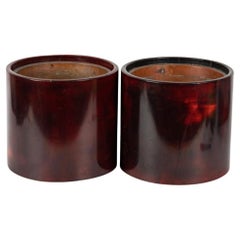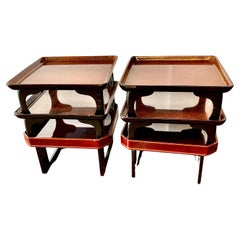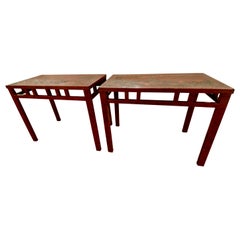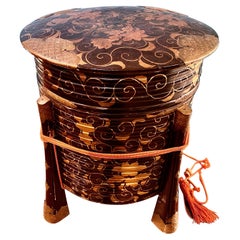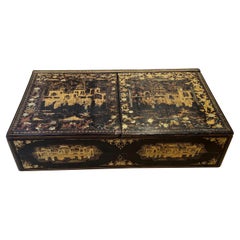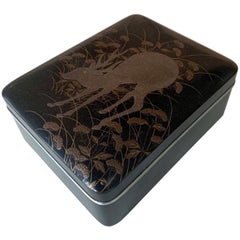MJH Design Arts Lacquer
to
3
4
4
2
2
1
4
4
1
1
4
4
3
1
4
4
4
Pair Japanese Lacquer Habachi
Located in Pasadena, CA
This is a beautiful example of the perfection of Japanese Minimalism design that dates to the Showa or possibly Taisho era. The simplicity of the circular form and minimal decoration...
Category
20th Century Japanese Showa Lacquer
Materials
Copper
$1,400 Sale Price / set
20% Off
Japanese Lacquer Trays
Located in Pasadena, CA
This is a wonderful collection of 6 mid-20th century Japanese Lacquer Trays. There is one pair of oxblood red with highlights; one pair of matched oil spot trays and one near pair of oil spot lacquer trays. All of the trays are in good overall condition with minor anticipated chips and patina to the edges. One of the cinnabar...
Category
Mid-20th Century Japanese Lacquer
Materials
Wood, Lacquer
$975 / set
Chinese Lacquer Consoles
Located in Pasadena, CA
This is an unusual pair of Late Ching Chinese cinnabar-toned coromandel lacquer small altar or side tables. The tops of the tables feature complementary incised and painted scenes from Chinese every day life. Both tables are in very good condition considering their 100+ years of use. It is unusual to find a pair of coromandel incised lacquer...
Category
Antique Mid-19th Century Chinese Chinese Export Lacquer
Materials
Wood, Lacquer
$3,815 Sale Price / set
30% Off
Japanese Lacquer Hokai Box, 19th Century
Located in Pasadena, CA
This is a good example of a traditional Japanese Hokai shell storage box for the Kai-awase game. This box is well-detailed in chased brass appliques and makie. The box is in overall ...
Category
Antique Late 19th Century Japanese Japonisme Lacquer
Materials
Wood, Lacquer
$1,175 Sale Price
24% Off
Related Items
Exceptional Chinese Export Gilt Black Lacquer Chinoiserie Decorated Lap Desk
Located in Atlanta, GA
Chinese export, circa 1820.
An exceptional quality and rare form. Featuring figural landscape decorations in gilt to the main black lacquer doors, which open to reveal 13 separated c...
Category
Antique Early 19th Century Chinese Chinese Export Lacquer
Materials
Giltwood, Lacquer
$2,072 Sale Price
20% Off
H 5.75 in W 23.25 in D 13.625 in
Japanese Rinpa Style Lacquer Box Meiji Period
Located in Atlanta, GA
A black lacquer tebako (hand box) with maki-e decoration and silver trim, circa late 19th century, Meiji period. The surface of the lid features a Rinpa style maki-e paint depicting ...
Category
Antique 1890s Japanese Japonisme Lacquer
Materials
Wood, Lacquer
Small Japanese Lacquer Duck Incense Box, Kogo, Meiji Period, Late 19th Century
Located in Austin, TX
An exquisite Japanese Meiji Period small lacquer incense box, kogo, in the form of a duck or goose, late 19th century, Japan.
The delicate lacquer box, known as a kogo in Japanese, ...
Category
Antique Late 19th Century Japanese Meiji Lacquer
Materials
Lacquer
$2,900
H 1.5 in W 2.88 in D 1 in
17th Century Japanese Export Lacquer Cabinet with Depiction the Dutch Tradepost
Located in Amsterdam, NL
A highly important Japanese export lacquer cabinet with depiction of the Dutch East India Company tradepost Deshima and the annual Dutch delegation on its way to the Shogun in Edo
Edo period, circa 1660-1680
H. 88 x W. 100.5 x D. 54 cm
This cabinet includes a later European japanned stand, but also a modern powder-coated steel frame.
The latter can be designed and added to your specific needs.
The sides and front of the rectangular two-door cabinet are embellished in gold and silver hiramaki-e and takamaki-e on a black roiro lacquer ground with a continuous design. The two doors depict a long procession of numerous figures travelling on foot and horseback along buildings and a pagoda into a mountainous landscape. This is the annual court journey, Hofreis, of the Dutch from Nagasaki to the Shogun’s court in Edo. Three horseback riders are dressed as Dutch merchants and a fourth figure, probably het Opperhoofd, is seen inside a palanquin, norimon. Just about to cross the bridge, two men are carrying a cabinet like the present one.
Many Japanese figures on either side of the procession are engaged in various activities; some play musical instruments on board of small boats, others are fishing; figures inside buildings are depicted playing go, and farmers are tending to their rice paddocks. The upper part of the right door shows a large mansion, probably the local daimyo’s castle, with men kneeling before a man in the central courtyard.
The court journey fits in with the foreign policy of the shogunate which accorded a role to the VOC alongside China, Korea, and the Ryukyu Islands who also had to pay tribute. However, the VOC employees were traders, having low status in Japan’s social hierarchy, and they were received with less deference than were the state embassies from Korea and the Ryukyu Islands. Nevertheless, the contacts with the Dutch were a welcome source of information to the Shogun about Europe and European science and technology.
The left side of the cabinet depicts, in mirror image, a rare view of the artificial fan-shaped Deshima Island, the trading post for the Dutch in Japan. The island, where the Dutch flag flies, is surrounded by small Japanese boats and an anchored three-masted fluyt (cargo ship), flying Dutch flags, with on the stern the VOC monogram. On the bottom right a busy street of Nagasaki is shown, bordered by shops and leading up to the stone bridge. On the island the trees are beautifully painted, two cows can be seen, and the flagpole, all in very fine detail. Dutchmen and enslaved Malay are visible outside the buildings and two Japanese figures, probably guards, sit in a small hut in the centre.
A maximum of fifteen to twenty Dutchmen lived on the island at any time and soldiers or women were not allowed. Restrictions on Deshima were tight, and the merchants were only allowed to leave the island by special permission. The Opperhoofd had to be replaced every year, and each new Opperhoofd had to make a court journey to pay tribute, present gifts, and to obtain permission to Margaret Barclay eep on trading. In the distance, many birds fly above the hills and a four-story pagoda can be seen. The right side of the cabinet is painted with other horse riders and their retinue journeying through mountains.
The pair of doors to the front open to reveal ten rectangular drawers. The drawers are decorated with scenes of birds in flight and landscapes with trees and plants. The reverse of the left door with two thatched buildings, one with a ladder, underneath a camelia tree with large blooms; the right door with a three-story pagoda nestled among trees and both doors with a flying phoenix, ho-oo bird. The cabinet, with elaborately engraved gilt copper mounts, hinges, lock plates and brass handles, is raised on an 18th-century English japanned wood stand.
A pair of large cabinets...
Category
Antique 17th Century Japanese Edo Lacquer
Materials
Copper, Gold
$1,487,230
H 34.65 in W 39.57 in D 21.26 in
Japanese Lacquer Tray With Cards
Located in New Orleans, LA
This Meiji-period lacquer tray represents the mastery of Japanese craftsmen in the art of lacquer work. Precious materials are precisely inlaid in the lacquer base, creating a highly...
Category
Antique Late 19th Century Japanese Meiji Lacquer
Materials
Gold
Chinese Chinoiserie Decorated Lacquer Panels, a Pair
Located in Bradenton, FL
Pair of stylish Chinoiserie panels in a lacquer finish, painted in gold, red & black with landscapes with village and people. The frame also decorat...
Category
Antique 19th Century Chinese Chinese Export Lacquer
Materials
Lacquer
Japanese Maki-e Lacquer Stack Box Jubako
Located in Atlanta, GA
An antique jubako (stack boxes) with five tiers in an elongated octagon shape circa 19th century (end of Edo or beginning of Meiji period). jubako was traditionally used to store and...
Category
Antique 19th Century Japanese Japonisme Lacquer
Materials
Wood, Lacquer
Rare Charming 17th Century Japanese Lacquer Cabinet with Gilt-Bronze Mounts
Located in Amsterdam, NL
A fine Japanese pictoral style lacquer cabinet with gilt-metal mounts
Kyoto, Edo period, 1670-1690
Decorated in Japanese relief lacquer work, black lacquer ground decorated...
Category
Antique Late 17th Century Japanese Furniture
Materials
Bronze
$44,616 Sale Price
25% Off
H 23.82 in W 24.02 in D 18.31 in
19th Century Chinese Lacquer Sewing Box
Located in Brea, CA
19th century Chinese lacquer sewing box from the Qing Dynasty. Decorated all over beautifully with intricate designs and images of ancient C...
Category
Antique 19th Century Chinese Qing Lacquer
Materials
Lacquer
Pair of Chinese Red Lacquered Console Tables
Located in Stamford, CT
A pair of Chinese red lacquered console tables from the 1940s.
Category
Mid-20th Century Chinese Furniture
Materials
Wood
A large square tray made of Japanese antique lacquer / Late Edo period/19th
Located in Sammu-shi, Chiba
These trays were made after the late Edo period in Japan (after 1800).
This particular type of tray is known as "Negoro-bon."
Negoro lacquerware is a specific style of Japanese lacqu...
Category
Antique 19th Century Japanese Edo Lacquer
Materials
Lacquer
$1,000
H 2.09 in W 17.84 in D 18.12 in
Vintage Japanese Lacquer Duck Box by Zohiko, Showa Era, Mid 20th Century, Japan
By Zōhiko Studio
Located in Austin, TX
A finely decorated vintage Japanese box for precious incense, kogo, in the shape of a male mandarin duck, oshidori, by Zohiko, Showa Era, 1960's, or earlier.
The lovely and whimsic...
Category
Vintage 1960s Japanese Showa Lacquer
Materials
Wood, Lacquer
$900
H 4 in W 7.5 in D 3 in
